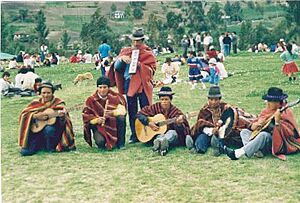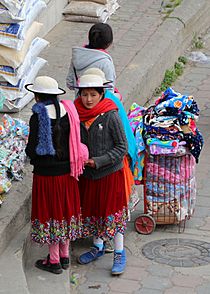Cañari facts for kids
Quick facts for kids
Cañari
Kañari
|
|||||||||
|---|---|---|---|---|---|---|---|---|---|
| 6th century–1533 | |||||||||

Location of Cañar in Ecuador
|
|||||||||

Panoramic view of part of the ruins of Pumapungo in Cuenca, Ecuador.
|
|||||||||
| Status | Civilization | ||||||||
| Capital | Tumebamba | ||||||||
| Common languages | Originally Cañari (now extinct or severely endangered), Kichwa, Spanish | ||||||||
| Religion | Polytheist | ||||||||
| Government | Diarchy | ||||||||
| Historical era | Integration | ||||||||
|
• Established
|
6th century | ||||||||
|
• Disestablished
|
1533 | ||||||||
|
|||||||||
The Cañari people (called Kañari in Kichwa) are an indigenous ethnic group from Ecuador. They traditionally lived in the areas that are now Azuay Province and Cañar Province. The Cañari are known for being a strong and independent group before the Spanish conquest. They bravely fought against the powerful Inca Empire.
Even though the Inca eventually conquered them in the early 1500s, the Cañari later teamed up with the Spanish to fight against the Inca. Today, thousands of Cañari people live in Ecuador, including many mestizos (people of mixed European and indigenous heritage).
The Cañari people defended their land for many years against the Inca armies. The Inca leader Topa Inca Yupanqui conquered some of their allies to the south. Later, the Inca Empire under Huayna Capac finally took over the Cañari territory. The Cañari were allowed to manage some of their own affairs, but they had to adopt a new language for talking with the Inca.
The Cañari mainly lived in the Tumebamba area, which is now the city of Cuenca, Ecuador. Their buildings were so impressive that they were often compared to the Inca capital, Cusco. Tumebamba was even called the "second Cuzco."
During a civil war between two Inca brothers, Huáscar and Atahualpa, the Cañari supported Huáscar. This was risky because they were in the northern area, which was Atahualpa's territory. At first, Huáscar's generals won some battles and captured cities like Cajamarca and Tumebamba. But Atahualpa fought back, defeated Huáscar's army, and punished the Cañari supporters when he reached Tumebamba.
Contents
What does the name "Cañari" mean?
The word "Cañari" comes from two words: "kan," meaning "snake," and "ara," meaning "macaw." Some experts believe this means the Cañari thought their ancestors were the snake and the macaw. Others think these animals were simply sacred to them, as shown in their stories and art.
What is the Cañari creation story?
The Cañari people had a special story about how the world began, which included a huge flood. This story is similar to flood myths found in the Bible and the ancient tale of Gilgamesh.
According to the Cañari myth, a giant flood covered everything, and only two brothers survived by climbing to the top of a very tall mountain. After the flood, they returned to their hut. To their surprise, they found it repaired and filled with prepared food every day. One brother, Urcocari, decided to stay and find out who was helping them. He discovered it was a woman with a macaw face. He married her, and together they repopulated the world.
How did the Inca conquer the Cañari?

The Inca Empire, led by Topa Inca Yupanqui, wanted to expand its territory. They first conquered the Paltas people, who surrendered easily. But the Cañari were much tougher. They were a large group and had prepared for a long time to defend their lands. They even chose a strong leader named Dumma.
Túpac Yupanqui attacked the Cañari quickly, hoping to surprise them. But the Cañari were ready and fought back fiercely. The Inca army had to retreat, realizing that defeating the Cañari would not be easy.
The Cañari felt brave after this victory. They secretly tried to get the Paltas to rebel against the Inca. However, the Paltas told Túpac Yupanqui about the plan. The Inca leader was very angry and decided he would not return home until the Cañari were defeated. He called for more soldiers from all over the Inca Empire.
When the Cañari saw the massive Inca preparations for war, their spirits began to drop. They decided to seek peace and sent messengers to the Inca, offering to join his empire. The Inca didn't trust them at first because the Cañari were known for changing their minds. To be sure, he demanded that Dumma and other Cañari leaders send their own children as hostages.
Once Túpac Yupanqui felt secure, he traveled to the Cañari lands. The Cañari welcomed him with celebrations and quickly built a palace for him. They showed great respect and happiness. The Cañari were then loosely brought into the Inca Empire. They could still manage some of their own affairs but had to learn the Inca language.
Túpac Yupanqui stayed in the area for a long time. He moved many Cañari people to Cusco and built bridges and buildings, both religious and non-religious. He wanted to win over the Cañari and make them loyal subjects. He also made Tumebamba more beautiful, and his son Huayna Capac was born there.
The Inca also built two fortresses and a residence in the mountains to help control the area. This marked the end of the Cañari's independence and the start of their time as part of the Inca Empire.
What happened during the Inca Civil War?
During the civil war between Huáscar and Atahualpa, the two sons of Huayna Cápac, the Cañari chose to support Huáscar. This was a risky decision because their land was in the northern part of the empire, which Atahualpa inherited.
At first, Huáscar's generals were successful. They defeated Atahualpa's army and captured many soldiers and important cities like Cajamarca and Tumebamba. However, Atahualpa, with the help of his father's loyal generals, fought back. He defeated Huáscar's army in major battles.
Atahualpa then captured and executed Huáscar's generals. When he reached Tumebamba, he severely punished the Cañari supporters. It is said that their population of 50,000 was reduced to only 12,000 people.
How did the Cañari help the Spanish?
When the Spanish leader Francisco Pizarro arrived in Tumbes, Peru, he heard that the Cañari were against Atahualpa's rule. The Cañari hoped the Spanish would free them from the Inca. So, Pizarro included Cañari soldiers in his army to fight against Atahualpa and the Inca resistance.
In 1536, Cañari and Spanish soldiers worked together to defeat the Inca in the battle of Sacsayhuamán. The Cañari continued to be important even under Spanish rule. A Cañari leader named Francisco Chilche became a powerful figure. He fought off other indigenous groups and even Spanish people who wanted land in the Sacred Valley. Because they were allies of the Spanish, the Cañari had legal rights and influence. Chilche remained important for many years, even recruiting 500 indigenous soldiers to help the Spanish fight against the last Inca ruler, Tupac Amaru.
Where did the Cañari live?
The Cañari were a group of tribes that formed a united people. They lived in an area stretching from the limits of Azuay to Saraguro, and from the Gualaquiza mountains to the Narajal beaches.
Important Cañari areas included Cañaribamba, Cojitambo, Chobshi, Shabalula, Molleturo, Coyoctor, Culebrillas, Yacubiñay, Guapondelig, and Hatun Cañar. After the Inca conquest, the last two settlements were renamed Tumebamba and Ingapirca. Today, you can still find ruins and archaeological sites from both Cañari and Inca cultures in these areas, located in the modern provinces of Azuay Province, Cañar Province, and El Oro Province in Ecuador.
Topa Inca Yupanqui renamed Guapondelig to Tumebamba. He built the palace of Pumapungo there, which became a key center for governing the northern part of the Inca Empire.
The largest known ruins that show both Cañari and Inca influence are:
- Ingapirca (in Cañar Province)
- Pumapungo (in Azuay Province)
- Chobshi (in Azuay Province)
- Yacubiñay (in El Oro Province)
Of these, Ingapirca is the most famous. Pumapungo is located in the center of Cuenca, Ecuador, behind the Museo del Banco Central. Chobshi and Yacubiñay have not been fully studied by archaeologists yet.
What was Cañari culture like?
The Cañari people likely had a system where different tribes were united under one main leader, like a group of small kingdoms. Each tribe had its own leader. But during big problems, like natural disasters or wars, all the tribes would come together and choose one single leader.
Some Cañari tribes had societies where women held important power or where family lines were traced through the mother. When the Inca married into these powerful Cañari families, they used these marriages to gain control over certain Cañari groups.
The Cañari used a lunar calendar, which means they tracked time based on the moon. They also built temples in circular or moon-like shapes. At Ingapirca, you can see examples of these round Cañari buildings right next to the rectangular Inca buildings. The site also has stone "calendars." These are stones with holes drilled into them at different angles. The holes were filled with water to reflect the sky, helping them track dates and seasons.
What happened to the Cañari language?
The original Cañari language is now almost completely gone. Very few people still speak it, and researchers have found it hard to learn much about it. Most indigenous people in Ecuador today speak Kichwa or Spanish.
During the Inca conquest, the Cañari learned Quechua (Kichwa). This language of the Inca conquerors picked up many Cañari words, especially for names of places like rivers and mountains.
Later, during Spanish rule, missionaries tried to translate religious texts into Cañari to teach the local people. However, no copies of these texts exist today. Over time, the Spanish rulers told the Cañari to learn Kichwa, which made the Cañari language fall out of use. Because there are so few written records, much knowledge about this language has been lost.
The Cuenca accent
Some people believe that the unique accent in Cuenca, Ecuador, comes from the original Cañari language. This accent is found in the areas where the Cañari used to live, especially in rural communities where it's stronger. This idea is supported by the fact that the accent is mostly limited to the provinces of Cañar Province and Azuay Province, unlike Kichwa, which is spoken more widely. There's also a similar accent in parts of northwestern Argentina and Bolivia. Some think this might be because the Inca moved Cañari people (called mitimaes) to these distant places during their wars.
Famous Cañari people
- Yaku Pérez Guartambel: An activist who fights for the rights of indigenous people. He was also a candidate for president in the 2021 Ecuadorian general election.
See also
 In Spanish: Cañari para niños
In Spanish: Cañari para niños




